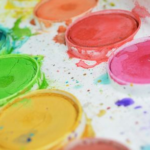Traditionally practiced in Kutch, Gujarat, the beauty of Lippan Kaam (as it’s known in Western India), or mud wall art, is undeniable, and yet so many of our country’s incredibly captivating traditional artforms are being left behind and forgotten about as modern life progresses, and people move on.
Lippan (meaning mud) Kaam (meaning work) is a special art form that uses mud and mirrors to create stunning wall hangings and murals, and which can breathe life into something bland and featureless. A wonderfully vibrant addition to any Indian home, using a range of colours, mirrors and patterns, Lippan was originally used to help keep homes – like mud huts known as bhunga’s – cool in hot and humid conditions, and used materials that were locally available, such as clay and camel dung.
How is Lippan created?
The traditional method of Lippan uses an equal combination of animal dung, mud or clay to form a dough. Once the dough is ready, the wall of the home is moistened to ensure that the dough sticks to it well, and a border is firstly created, to act like a frame. Then, the surface is divided into lines that are vertical and horizontal.
Rolled into cylindrical strips, the dough is then used to make intricate and precise patterns on the wall (or whatever surface is being used). In earlier years, big mirrors were shattered so that the small shards could be used to create intricate designs of a repetitive nature. Mud and dung were then formed around the patterns, and once dry, the artwork would be covered in white sand or white clay from the Kutch salt marshes.
With every step of the process completed by hand, and time needed for the mud to dry between each phase of the piece, Lippan Art takes many days and weeks to create.
What does Lippan Art look like?
Many different themes and ideas can be represented in mud work, and you will often see creatures such as peacocks, elephants and camels, mango trees, temples, and daily exercises of the local Kutch people, depicted in them.
Usually completed freehand, Lippan Art often features shapes and geographic structures, and can be seen on the walls, roofs, entrances and floors of homes.
Why should we cherish Lippan Art and even learn it ourselves?
If you’re a creative type of person, or someone looking for a way to become more creative, learning Lippan Art is a wonderfully unique and beautiful way to do exactly that. Steeped as it is in ancient history and tradition, Lippan Art can help people connect with their ancestors and appreciate the same kind of beauty that has been marvelled over for centuries.
Here are a few reasons why Lippan Art should be cherished, and this centuries old tradition kept alive:
- It’s a sustainable art form – locally sourced materials are used and dyes are always natural, minimizing its impact on the environment
- It’s empowering – the upkeep of such a tradition can help rural artisans earn a living for themselves and their family
- It blends tradition with innovation – modern artists have many new ways of interpreting this ancient craft, while maintaining the integrity of its cultural significance
- It’s very symbolic – Lippan artwork has many different meanings within it, and can represent many different things
- It looks great on, or in, any home – even modern homes can benefit from the cultural beauty of Lippan Art, which can be designed as per your exact wishes
If you’d like to do more than merely appreciate Lippan Art, and would like to learn the techniques associated with this wonderful and ancient tradition for yourself, why not check to see if any art studios in your area are offering Lippan Art lessons, and sign yourself up for a course.



